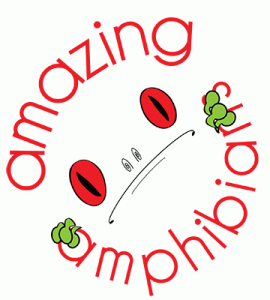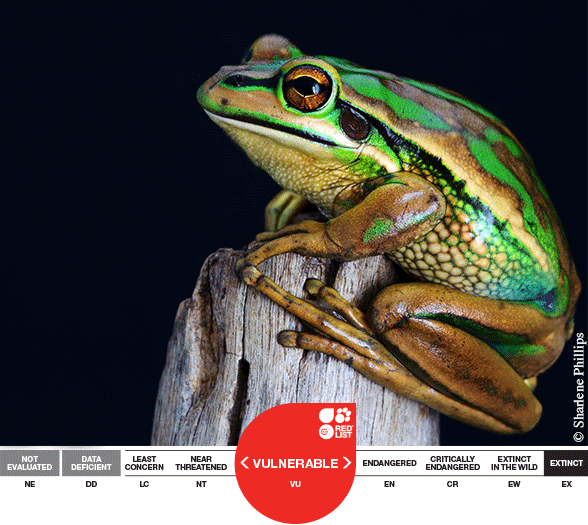 The Green and Golden Bell Frog, Litoria aurea, is a large native Australian frog. It’s so big it’s been known to eat mice! It can be found in Australia’s lower elevations from East Gippsland in Victoria to Byron Bay in New South Wales. It has been introduced to New Zealand, and is shuttled between the North and South Islands by pet traders, although it is only found in the wild in the upper half of the North Island. The Green and Golden Bell Frog is listed as ‘Vulnerable’ on the IUCN Red List of Threatened SpeciesTM.
The Green and Golden Bell Frog, Litoria aurea, is a large native Australian frog. It’s so big it’s been known to eat mice! It can be found in Australia’s lower elevations from East Gippsland in Victoria to Byron Bay in New South Wales. It has been introduced to New Zealand, and is shuttled between the North and South Islands by pet traders, although it is only found in the wild in the upper half of the North Island. The Green and Golden Bell Frog is listed as ‘Vulnerable’ on the IUCN Red List of Threatened SpeciesTM.
 |
There are likely to be multiple causes of decline in this species, including disease due to chytrid fungus. Chytrid fungus appears to be a contributing factor in the decline and loss of a number of populations and a factor limiting the success of reintroductions. Additional threats include habitat loss and the impact of introduced fish. Before its decline, this species was considered to be one of the most common frog species in south-eastern Australia.
The Green and Golden Bell Frog occurs in several protected areas, and lots of research into its threats and conservation have been done. Newcastle University have an active research and reintroduction program for this species, investigating the impact of disease on populations. Taronga Zoo have also conducted reintroduction programs, releasing around 27,000 captive-bred tadpoles and frogs since 1996 at five different sites near Sydney.
Submit your observations of this species to iNaturalist and they will appear on this map. Learn more about this species on Amphibiaweb.
More Amazing Amphibians here.
Produced in partnership with:
Senior Partners |
|||
 |
 |
 |
|
 |
|||
Focal Partners |
|
 |
|
Affiliates |
|||
 |
 |
||
 |
|||
How to become an Amazing Amphibians partner:
Outlined below are the roles and responsibilities for the 4 different levels of involvement for potential partners. If your organization would like to be a part of the Amazing Amphibians program in either of these capacities please email amazing@amphibians.org.
Senior Partner – These partners will help with multiple aspects of the program, help facilitate the completion of several species profiles, publicize each Amazing Amphibian and will likely have a landing page for the program on their website. This level of partner will be leading in using their communication channels to gather additional information for the program such as images and data points for iNaturalist.
Strategic Partner – These partners will play an active role in creating species profiles, submitting at least three species profiles per year and actively use their social network to publicize each Amazing Amphibian. This level of partner will be active in using their communication channels to gather additional information for the program such as images and data points for iNaturalist.
Focal Partner – Partners tend to be active in a limited geographic area. This partner will submit at least one regional species profile per year and use their social network to publicize each Amazing Amphibian. This level of partner will be involved in using their communication channels to gather additional information at a regional level for the program such as images and data points for iNaturalist.
Affiliate – These partners are interested in promoting the program but might not be in a position to provide profiles. These partners will publicize each Amazing Amphibian through the social media outlets.







